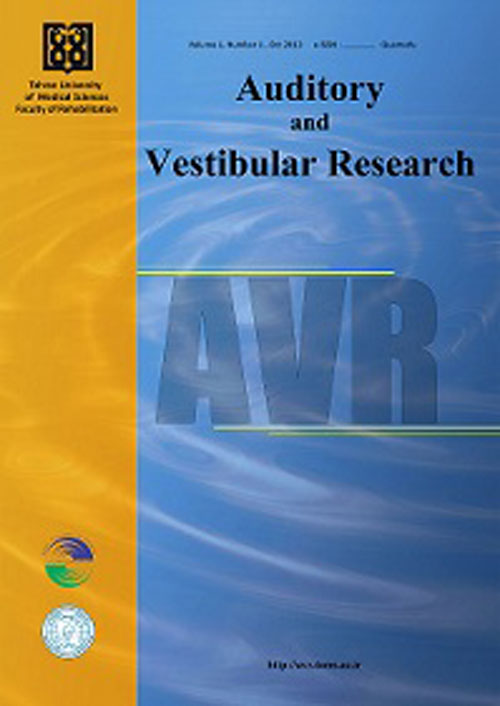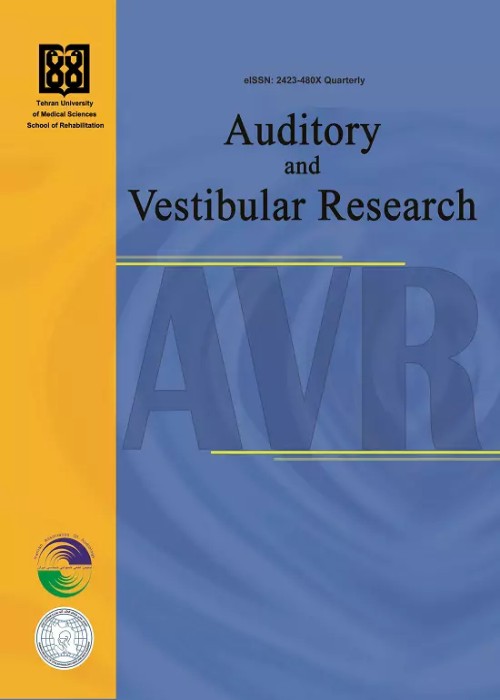فهرست مطالب

Auditory and Vestibular Research
Volume:26 Issue: 1, Winter 2017
- تاریخ انتشار: 1395/12/21
- تعداد عناوین: 8
-
-
Pages 4-13Background And AimIt has been several decades since the technology of frequency lowering (FL) has been proposed. However, primary research has revealed no benefits regarding the use of this technique. Currently, new methods for FL and improvement of perception of speech and fricative sounds have led to the application of these methods by numerous companies to produce hearing aids. In this study, through reviewing the findings of recent studies we introduced several FL techniques used in various companies.Recent FindingsResults of studies conducted since the year 2000 on FL technology suggested that this technology could be used to improve speech perception in cases of high frequency hearing loss. Today, the majority of hearing aid manufacturers use different FL methods.ConclusionWhile the setting principles of FL methods are still vague, improved hearing of fricative sounds has been associated with increased use of this technique by researchers. FL technique has its own benefits and setbacks, understanding of which would facilitate the use of FL techniques and adjustment of hearing aids for hearing-impaired individuals.Keywords: Frequency lowering, transposing frequency, frequency compression, non linear frequency, compression, linear transposing frequency
-
Pages 14-20Background And AimHearing impairment affects educational skills of hearing-impaired students, but its negative impact is far more on reading and writing skills. This study was performed to design and validate an educational software to improve writing skills.MethodsIn this study, the mixed-methods approach was used. In the first step, the qualitative method was used to design the educational software, which was based on the main themes of the conceptual model of the writing skill curriculum provided by Sharifi et al. (2016). Afterwards, quantitative method was used to validate the software. In so doing, we enrolled 31 teachers working in hearing-impaired special primary schools.ResultsThe results indicated that more than 50% of the participants approved the software in terms of objectives, content determination, appropriateness of time of teaching the content, appropriateness of the selected places related to the learning subject, diversity of techniques with regard to individual differences, variety of techniques to control organizational shortcomings, as well as appropriateness of the educational software for improving language skills, social relationships, as well as educational achievement in all the curricular areas.ConclusionDesigning an educational software capable of considering all the influential aspects and components for writing skill improvement can improve writing skill of hearing-impaired students.Keywords: Educational software, hearing impaired, writing skills, validation
-
Pages 21-26Background And AimHearing loss is one of the most prevalent disabilities. Children with severe-to-profound sensorineural hearing loss (SNHL) normally experience numerous problems. However, the extents of educational and communicational problems are not usually diagnosed in these children. Therefore, the aim of the current study was to compare children with hearing loss using hearing aids with normal children through the Persian version of parents evaluation of aural/oral performance of children (PEACH).MethodsThis study was conducted on 56 children with mild to severe hearing loss using hearing aids and 56 children with normal-hearing ability by utilizing the PEACH questionnaire for a week.ResultsThe mean score in quiet showed a significant difference between the two groups (p=0.006), although there was no significant between-group difference in terms of mean score in noise places (p=0.100). The mean overall score also showed a significant difference between the two groups (p=0.012).ConclusionThe results indicated that the PEACH questionnaire is a useful tool in the study of performance and effectiveness of hearing aid in children and its adjustment.Keywords: Hearing impaired child, hearing aid, parent's evaluation of aural, oral performance of children
-
Pages 27-33Background And AimWith regard to the shortage of proper materials in Persian for the evaluation of speech perception in children, this study aimed to develop the Persian version of the BKB sentence test, and determine its content validity in normal Persian speaking children aged 6-12 years.MethodsThis study was an applied research. The study procedure comprised sentence construction, determining their content validity, and degree of difficulty when presenting to 15 normal children with noise background. The selected sentences were short with high redundancy, a simple structure, and containing words appropriate to vocabulary of grade one and two children. Content validity of the sentences was determined by Lawshe method through presenting them to 10 experts. Sentences were presented in different signal to noise ratios (SNRs) to 15 children aged 6-12 years. The average SNR for each sentence was determined. The upper and lower limit to select the final sentences were determined by calculating the average and standard deviation of SNR to perceive the sentences.ResultsAccording to experts opinions, out of 220 selected sentences, 200 sentences obtained acceptable level of content validity (CVR˃0.62). In addition, analyzing the data from the average SNR for sentence perception revealed that 43 sentences were harder or easier than the acceptable range that were removed from the sentence package. The remaining 157 sentences were categorized into 10 equivalent lists.ConclusionThe findings indicate that the Persian version of the BKB sentence test has good content validity and is applicable in research and clinical studies.Keywords: BKB sentence, validity, Persian, signal to noise ratio
-
Pages 34-40Background And AimHearing impairment is one of the common disabilities quality of life of mothers of children with hearing impairment are often lower than others. This study aimed to evaluate the effects of life skills training (LST) on the quality of life of mothers who have children with hearing impairment.MethodsAn experimental research method (pretest, post-test with control group design) was followed in this study. The statistical population comprised all mothers who have children with hearing impairment and lived in Shiraz, Iran. Of them, 36 mothers were selected through purposeful sampling method and randomly divided into two 18-member groups (experimental and control groups). The pretest was conducted on both groups. LST program was performed in the experimental group in 12 sessions, and the control group did not receive any intervention. Post-test was conducted on both groups. The quality of life scale (QOLS) was used to assess each mothers quality of life.ResultsLife skills training causes significant improvement in the mean scores of the mother's physical health, mental health, social relationships and ultimately quality of life in the experimental group (pConclusionAccording to this study, LST is effective in improving the quality of life of mothers who have children with hearing impairment. This program so it can be considered as a useful tool in this field.Keywords: Life skills training, quality of life, children with hearing impairment
-
Pages 41-49Background And AimsConsidering the fact that different components of linguistic knowledge are not equally vulnerable, this study investigated the knowledge of argument structure of verbs in a group of deaf Persian speakers, as people who have been deprived of linguistic data during the early years of their childhood that is the critical period of language acquisition.MethodsIn this study, the knowledge of verb arguments was examined through two tasks, one written (for 10 verbs) and one pictorial (for 10 verbs), in the two groups of deaf and normal hearing individuals, each of which consisting of 12 participants (6 girls and 6 boys).ResultsThe analysis of verb argument structure showed that the number of errors in pictorial tests and recognized verb arguments was not significantly different between the groups. However, the main challenge of the deaf participants was attributed to mapping the arguments of the verb onto syntactic level.ConclusionThe results showed that linguistic levels are not equally dependent on the successful experience of the critical period. The syntax level was highly affected by the critical period, while concepts like verb arguments had the least vulnerability.Keywords: Argument structure, critical period hypothesis, deaf, language acquisition
-
Pages 50-55Background And AimFor various reasons hearing-impaired people have stress and fear of being in social situations. Cognitive behavioral therapy (CBT) is known as one of the most valid therapies of social phobia. The aim of this research was to show the efficacy of cognitive behavioral therapy on the level of social anxiety in hearing-impaired adults.MethodsThe study population consisted of hearing-impaired people aged 20 to 30 years old. Of 30 individuals that selected through simple sampling method, 20 with high scores in anxiety disorder diagnosis interview, were assigned into experimental (n=10) and control (n=10) groups. Cognitive behavioral therapy was performed for the experimental group. Social phobia components (Fear, avoidance, and physiology) were determined by social phobia inventory and structured clinical for interview for DSM-IV.ResultsMean social phobia scores is less in the experimental group compared to the control group. Also mean scores of social phobia components (fear, avoidance and physiology) was less in the experimental group than in the control group (pConclusionCognitive behavioral therapy is efficient in decreasing social phobia in hearing-impaired adults and in reducing most components such as fear, physiologic discomfort and avoidance in social situations.Keywords: Impaired, hearing adults, cognitive behavioral therapy, social phobia


